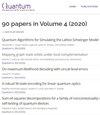Spatially-Coupled QLDPC Codes
IF 5.1
2区 物理与天体物理
Q1 PHYSICS, MULTIDISCIPLINARY
引用次数: 0
Abstract
Spatially-coupled (SC) codes is a class of convolutional LDPC codes that has been well investigated in classical coding theory thanks to their high performance and compatibility with low-latency decoders. We describe toric codes as quantum counterparts of classical two-dimensional spatially-coupled (2D-SC) codes, and introduce spatially-coupled quantum LDPC (SC-QLDPC) codes as a generalization. We use the convolutional structure to represent the parity check matrix of a 2D-SC code as a polynomial in two indeterminates, and derive an algebraic condition that is both necessary and sufficient for a 2D-SC code to be a stabilizer code. This algebraic framework facilitates the construction of new code families. While not the focus of this paper, we note that small memory facilitates physical connectivity of qubits, and it enables local encoding and low-latency windowed decoding. In this paper, we use the algebraic framework to optimize short cycles in the Tanner graph of 2D-SC hypergraph product (HGP) codes that arise from short cycles in either component code. While prior work focuses on QLDPC codes with rate less than 1/10, we construct 2D-SC HGP codes with small memories, higher rates (about 1/3), and superior thresholds.空间耦合QLDPC码
空间耦合码(SC)是一类卷积LDPC码,由于其高性能和与低延迟解码器的兼容性,在经典编码理论中得到了很好的研究。我们将环面码描述为经典二维空间耦合(2D-SC)码的量子对偶,并将空间耦合量子LDPC (SC-QLDPC)码作为推广引入。我们利用卷积结构将2D-SC码的奇偶校验矩阵表示为两个不定式中的多项式,并推导出2D-SC码成为稳定器码的充分必要代数条件。这个代数框架有助于构建新的代码族。虽然不是本文的重点,但我们注意到小内存有助于量子比特的物理连接,并且它可以实现本地编码和低延迟的窗口解码。在本文中,我们使用代数框架来优化2D-SC超图积(HGP)码的Tanner图中的短循环,该Tanner图由任一分量码的短循环产生。先前的工作主要集中在速率小于1/10的QLDPC码上,而我们构建的2D-SC HGP码具有更小的内存、更高的速率(约1/3)和更好的阈值。
本文章由计算机程序翻译,如有差异,请以英文原文为准。
求助全文
约1分钟内获得全文
求助全文
来源期刊

Quantum
Physics and Astronomy-Physics and Astronomy (miscellaneous)
CiteScore
9.20
自引率
10.90%
发文量
241
审稿时长
16 weeks
期刊介绍:
Quantum is an open-access peer-reviewed journal for quantum science and related fields. Quantum is non-profit and community-run: an effort by researchers and for researchers to make science more open and publishing more transparent and efficient.
 求助内容:
求助内容: 应助结果提醒方式:
应助结果提醒方式:


